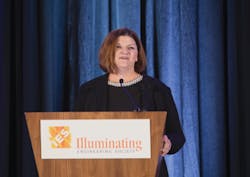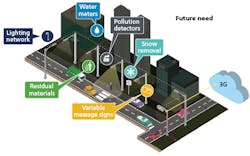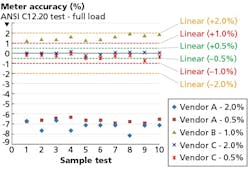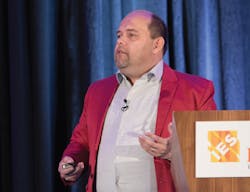The transition to LEDs in street lights is happening rapidly, but it's the symbiotic network and control technology that can enable smart city applications which excited the IES SALC crowd, reports MAURY WRIGHT.
The Illuminating Engineering Society (IES) Street and Area Lighting Conference (SALC) took place in Austin during September, and as always was a great place to learn about recommended practices for LED-based outdoor lighting. But as has been the case in recent years, the presentations leaned more toward smart interconnected lighting, the Internet of Things (IoT), and how solid-state lighting (SSL) can enable and empower smart city applications ranging from parking control to environmental monitoring to security. There were real examples of networked lighting being installed, although it appears at this point that those installations remain in the minority. Still, smart city applications hold tremendous potential.
Interested in articles & announcements on LED lighting applications?
As is commonplace at SALC, the conference kicked off with presentations from outdoor lighting stakeholders within organizations local to the venue. Elaina Ball (Fig. 1), COO of Austin Energy, opened the show, saying, "We like many other utilities in the room have some bold and ambitious objectives. We have a plan that is setting forth objectives to reduce our carbon emissivity and improve our affordability and competitive position. And those can be very challenging - both of those activities sometimes compete with one another. LEDs and outdoor lighting are a wonderful nexus where we can achieve both of these objectives."
Austin has a program in place that will strive by 2027 to reach a point where 65% of supply side resources will come from renewable sources. "We also have some bold objectives to reduce 900 MW of consumption side energy by 2027, and that's really where our lighting program comes in," said Ball. The city currently has 59,000 street lights and about 25% have been converted to LED sources.
Ball also said the city has deployed controls to monitor performance, whereas before authorities relied on customers to report outages and had to roll trucks out to investigate, although she did not say how many lights the control network is installed on. She added that they are controlling light levels in some cases. Rhetorically, Ball asked if anyone in the room was planning to visit the notorious 6th Street entertainment district while in Austin. She said, "You don't have to admit it. What happens in Austin stays in Austin." Then she described what one might witness if they happen to be on 6th Street at 2:00 AM when the entertainment venues start to close. "We actually brighten our lights in the entertainment districts in order to promote safety for folks to walk back safely to their hotels," said Ball.
FIG. 1. Elaina Ball of Austin Energy described how the city raises light levels at 2:00 AM in the entertainment districts so revelers can get home safely.
Don't pitch efficiency first
Next up from the local area was Ted Lehr (Fig. 2), a data architect with the City of Austin, who delivered the SALC keynote. And Lehr immediately got to the issue that manufacturers in the room were keen to hear - how to sell street lights to municipalities in the LED era. Lehr said saving money is always a secondary goal and that something else is always first for the stakeholder contemplating a street light tender.
Lehr answered a question that many in the audience may have wondered about when he noted his job title and suggested that there was no direct connection to street lighting. But he said, "Nearly all of the new technologies have something to do with data." And Lehr counsels the mayor and city on data issues relative to systems such as lighting.
But Lehr said he has learned that city executives are overwhelmed by technology and that's where he got back to the message that cost savings come second, because he translates technology stories into business cases for the executives. He said, "Know that you are talking to the second priority of the executive" when you address cost savings. He continued, "You probably should address the first priority."
Relating the message back to Austin, he said the city cares a lot about being a technology hub in areas such as wireless communications, so the city authorities would naturally be interested in technology-focused smart city and smart lighting initiatives. Moreover, Austin remains a very artistic-driven community and aesthetics are very important to the city.
Aesthetics matter
Regarding LED lighting in the city, Lehr said, "It's not just the safety, [although] the safety is very important, but the aesthetics." Based on his experience with projects, he said, "The lighting proposals that have a community touch, not just a cost-savings touch, or a public safety touch, but the 'light the community' [angle] gets the attention of our city council, gets the attention of the policymakers." He said that if the proposal talks about the aesthetics for the community, the impact and the size of the installation grows in magnitude.
One other surprising concept mentioned by Lehr was augmented reality (AR) technology. He noted, "It is appealing to us." What he meant was the use of AR in a way that allows the community and municipal officials to see what a lighting project might look like once it's completed. He said AR can get buy-in from the community in that the motivation for a project is doing something good for the community. He said AR was also being evaluated as a maintenance tool for city services including street light maintenance.
TABLE. Factors include sensitivity and latency for outdoor data transmission tasks.
As for smart and connected street lighting, Lehr said Austin is looking for places to locate intelligence, and street light poles or what he called a "multipurpose lighting infrastructure" are an excellent candidate. The city wants to monitor vehicle and pedestrian traffic, among other applications. But again, he said the smart pole has to be pretty.
Interoperable controls
Lehr's talk hinted at smart interconnected lighting, and soon the conference would move decidedly in that direction for the bulk of the presentations. One of the most compelling came from Isabelle Lessard, an engineer and project manager with the city of Montreal, QC, Canada. And the compelling point was interoperability, as you will soon learn.
At the onset of an LED conversion program, Montreal had what you might term a dysfunctional situation in street lighting. The city had around 133,000 fixtures and 146 different models installed. Around 96% were high-pressure sodium (HPS) luminaires. Lessard said the city needed to streamline the system and at the same time move to LED technology. Moreover, the city decided to install wireless controls at the same time it retrofitted to LED sources; Lessard said the city wanted to eliminate the need to visit each pole twice and controls were clearly in their future.
The challenges ranged from simple to complex. For instance, Lessard said 45,000 of the fixtures are decorative in nature. And she pointed out that most wireless nodes that are unobtrusive on top of a cobrahead luminaire mounted 30 ft in the air are just ugly on a decorative fixture mounted at pedestrian scale. The city had to find controls that could be mounted inside the fixture.
FIG. 2. Ted Lehr of the City of Austin warned manufacturers not to sell street lighting based on energy or cost savings but on whatever the primary priority would be for the customer at hand, such as aesthetics or smart city capabilities.
But it was the city's insistence on a multi-vendor interoperable smart-lighting system that garnered the most notoriety. Lessard said controls vendors discussed future interoperability but in reality were expecting customers to be reliant on their proprietary technology, and added, "That was in contradiction with the city's open data mindset." And the city wanted to be able to scale up the deployment later without being tied to a vendor.
Changing the market
Lessard said there was no solution on the market that met the project goals. "What was the next step?" she asked. "We changed the market." Because Montreal authorities were entering the market with the potential procurement of 135,000 fixtures, they felt that they could have vendors make concessions and they asked for interoperability on all functionality. Moreover, the interoperability would have to be proven in bench tests.
They sought a distributor or energy services company that could deliver three vendors that would supply field gear - both network nodes for the luminaires and network gateways. And the bidding company would select one company to supply the central management software that had to work with the varied gear in the field. Ultimately, the city got four qualified proposals and selected the best one based on criteria including cost, but also the interoperability testing, experience of the bidder, and technical compliance.
The installation began at the beginning of this year. Thus far the city has 100 gateways installed and has moved into a year-long phase of commissioning and testing the system. Lessard said there will be 10,000 nodes up and running by the end of the year, and work with the software management platform is going well so far. Once the system is functional, the additional 120,000 poles will be retrofitted over five years.
Lessard said that as a customer, you should demand the capabilities you need and vendors will work harder than you might expect to meet your requirements. For Montreal, the payoff is flexibility and independence from relying on a single vendor. And the city expects to add more functionality to its street-light network going forward through sensors for snow level, pollution, and more as depicted in Fig. 3.
One other aspect of the Montreal project that's interesting is the inclusion of energy metering in the luminaires. Lessard said the city was working with utility Hydro Quebec to validate the metering capability and have it accepted as a utility grade meter, so the city pays only for the energy it uses. That sounds like a perfectly valid idea and another valuable benefit for smart connected outdoor lighting, although there are some challenges to it.
FIG. 3. Montreal's interoperable street-light controls supplied by three vendors will allow the company to layer on additional sensor-based applications such as air-quality monitoring and the need for snow removal services.
Energy metering in luminaires
There was another presentation made jointly by Jack Hanley, vice president for the Americas at Telensa, and John Walter, manager of outdoor light for New York at National Grid, that focused specifically on metering - both as a benefit enabled by connected lighting and the perils that await adopters.
Many of the wireless nodes on the market can be equipped with a revenue-grade metering chip. There are many reasons for metering street lights and providing tariffs based on the meter, starting with public pressure on utilities to provide transparency into their billing. Traditional street light tariffs are based on a flat calculation of hours multiplied by rated wattage multiplied by rate, but citizens want more accuracy and municipalities are looking to acquire and own their street lights and need accurate energy data. With meter chips, you can potentially even monitor energy use in real time.
Hanley described a case study with an unnamed utility that had agreed to tariffs based on a meter and a time of use rate. He said the utility agreed to ±1% meter accuracy for all outdoor lighting. The tight accuracy specification is due to the fact that the in-node meters measure relatively low Wh (watt hours) per fixture as opposed to utility-grade meters measuring aggregate power in a facility at the kWh level and requiring ±2% accuracy. The utility in the case study is relying on a modification to the ANSI C12 standard to guide the process. Hanley further described testing in a meter shop that showed the street-light-based chips can meet the accuracy requirements.
Of course, the utility has a logistics problem in terms of moving to such metered billing. Hanley described the procedures the utility in question went through to gather the meter readings and ultimately produce the energy report and bill at the end of a billing period.
Not so fast
Walter then took the podium to examine the issue from the utility perspective and asked if solid-state metering is ready for primetime. The perception, he said, is that it's a plug-and-play problem but at the end of his talk he would describe it as "plug-and-pray." He said that in reality it's complex with ownership, operation, security, and many more issues.
The data in Walter's talk came from a solid-state metering accuracy project undertaken in Rhode Island at the behest of the Rhode Island Public Utilities Commission. The test involved three manufacturers of wireless nodes with meter chips from three different manufacturers and 18 luminaire models from four different manufacturers. The test included varied load and operating schedules and even sought to develop the back-end interface to the billing system.
The project included bench testing in what they call a meter farm in a controlled environment, where accuracy at various loads could be assessed. Then the test moved to a full-scale field deployment with environmental factors present and multiple operational schedules.
Walter presented some preliminary observations that alone aren't positive for the metering proponents. He said the meter chips did not come with the independent laboratory testing documentation that is considered a requirement in utility-grade meters. Furthermore, he said few independent laboratories are even capable of testing the wireless nodes with meter chips integrated.
He then showed some performance observations (Fig. 4). The accuracy ratings specified by the manufacturers for each of the meter chips are shown in the key on the upper right of the graph. Clearly, the meters from Vendor A did not perform as specified, while the others did quite well at full load.
FIG. 4. The accuracy of energy metering chips in street-light wireless modes remains problematic for tariffs based on actual energy usage.
Beyond accuracy, Walter noted other issues. The meter chips will ultimately come from many vendors and the utility may or may not know the source of the meter chip or even the luminaire. Moreover, agents or distributors may supply the products and other entities may install the luminaires and node controls. The potential for finger pointing when problems occur is enormous. While there are some instances of metering being carried out today, the point made by Walter is that the industry is a long way from plug-and-play.
Smart city applications
Of course, there are many other potential applications for interconnected outdoor lighting. Most involve adding sensors to poles that can send data back to the cloud for processing. Ricardo Alvarez (Fig. 5), a PhD candidate at MIT and researcher in the university's Senseable City Lab, addressed some of the applications that are commonly discussed relative to smart street lighting, but that may yet pose some unexpected challenges.
Alvarez said, "Cities around the world are reinventing themselves - are trying to understand how they migrate from what is considered to be the physical cities of the 20th century, cities that are built of bricks, of buildings, of roads and streets to digital cities, cities that have layers of information embedded to them." The data comes from a variety of systems and transactions inherent in the digital cities. "We are sort of figuring out what that data means and scale, and what that data can be used for," said Alvarez. "And there's a role for that if we think about street lighting."
But Alvarez warned that we have to think differently about street lights. He said that while the lights are ubiquitous, the focus has always been about cost and quality of light. He stated that data is now a third variable that is a source of urban knowledge.
Now you may have heard much of what Alvarez had to say to this point before. But where he went next was a bit unique, because he began to discuss the sensor architectures and computational architectures that would be required to enable some applications that have been discussed relative to street lights. He said, "Street lights may be worth more because of the real estate they hold rather than the light that they provide."
He did cite some advantages street lights offer in enabling the vision he would espouse. We've heard these before. They are ubiquitous and powered. The size is right. Cameras can ideally be mounted up top and sensors for air quality and other things can be mounted 8 ft above the ground. He said the pole is an optimal form factor for sensors.
Technical sensing challenges
Still, the technical challenge may be tougher than many have suggested. Alvarez's lab has been working with Philips Research on trial projects in Cambridge to find use cases that make sense.
Part of the work is getting multiple uses out of one sensor such as a camera. If you install a camera on a pole, you should be able to use it to monitor pedestrians, automotive traffic, parking, and more. You have to decide what an application needs in terms of accuracy and other characteristics such as latency.
For example, consider a safety crossing application. Alvarez said it requires 100% detection capacity with zero latency. He said, "You need to be absolutely sure that you detect every person crossing the street." Parking, on the other hand, requires a high degree of detection accuracy but is a slow-moving system and a delay of a minute or two won't break the system.
Consider the numbers. To monitor moving cars on a roadway, you need to capture data at 15 frames/sec, which equates to a data throughput of 5 Mbytes/sec. To process that data, Alvarez said you need a "pretty beefy computer on board," which would be expensive; or you need an architecture to transmit the data, which may create latency problems. With parking, you may only need to sample one frame every 30 seconds. That takes the data throughput down to 11 kbytes/sec (see table). But both applications utilize the same sensor.
Smart city architects will have to carefully select the combination of sensors that might be deployed and how they are used. Temperature sensors are cheap and generate little data. You can install them anywhere. Cameras are also getting very cheap, but dealing with the output stream can be expensive. Thermal sensors, which can be a surrogate for a camera, are much more expensive but can lower the data rate and also eliminate privacy concerns that are common with cameras.
Alvarez's team is working on applications such as parking and the idea that a standard 20×8-ft parking space is not an optimal use of real estate given the diversity in car sizes. Acting on that fact may take a while, but the team can already detect occupancy and measure the size of cars. The system can further be used to detect parking violations.
FIG. 5. Ricardo Alvarez of MIT is researching smart city applications including parking control and enforcement, traffic control, environmental monitoring, and more.
Alvarez also discussed the control of traffic intersections. For example, a city might dynamically change traffic flow based on pollution measurements at one or more intersections. That type of capability might be mined by cities from the gathered data.
CCT and SPD
There was, of course, much more discussion of smart city applications enabled by connected street lights. But here we need to address some light quality issues as we close our coverage. Everyone at the event agreed that glare is bad and that we need better fixture and lighting design. And protecting the dark sky is important. Yet the recommendation made by the American Medical Association that municipalities install warm-CCT street lights hung like a pall over SALC.
No one at SALC wanted to admit that the AMA has had any impact on street light installations. For example, Kevin Fitzmaurice and Jessica Tolley from Georgia Power presented an update on that utility's LED retrofit project, which by the way includes controls on all new installations and replacements. As we discussed in our SALC coverage two years ago, the utility believes that it can justify controls just through the benefits in automatic commissioning. The utility has now installed more than 200,000 LED luminaires, all with controls.
But the SALC presentation this year included a lot of talk about CCT. The Georgia utility has transitioned to 3000K-CCT lighting for streets. It said it came to that decision based on some complaints by customers and not due to any influence from the AMA. It made the switch in both street and roadway fixtures last fall. For now, area lighting such as parking lots remains a standard 4000K install. Residential security lights will transition to 3000K later this year.
Back to the Montreal project we discussed earlier, it was delayed by 18 months after the CCT issue arose. Now the controls issue may have delayed the project anyway, or maybe the delay made the controls decision an easier one. But the city ultimately decided to install 3000K lights rather than 4000K lights. The trend is clear despite the fact that multiple SALC speakers reminded the crowd that spectral power distribution (SPD) and not CCT is the proper way to contemplate light issues, and that the best data on the topic of object detection under street lights indicates 4100K is safer.
Current IES president Cheryl English made it clear at SALC that the IES considers the AMA's activity inappropriate. The AMA did not have outdoor lighting experts on the committee that issued the recommendation. And the AMA has refused to collaborate with the IES. But perhaps the AMA has gotten its way nonetheless.
Back to a more positive topic, let's hope that the optimism surrounding smart cities and smart lighting is in fact going to lead to broad deployment of connected street lights. It's clear today that a lighting manufacturer can't get in the door at a potential customer site without a network and controls offering. But conversation around the SALC lunchtables indicated that the controls are often still eliminated late in the purchase process as a way to cut costs. Our own Strategies Unlimited market research business has also questioned just how prevalent connected street lighting will be, despite the potential benefits. For more information on their projections for connected lighting, see our coverage of talks at Strategies in Light from earlier this year.











